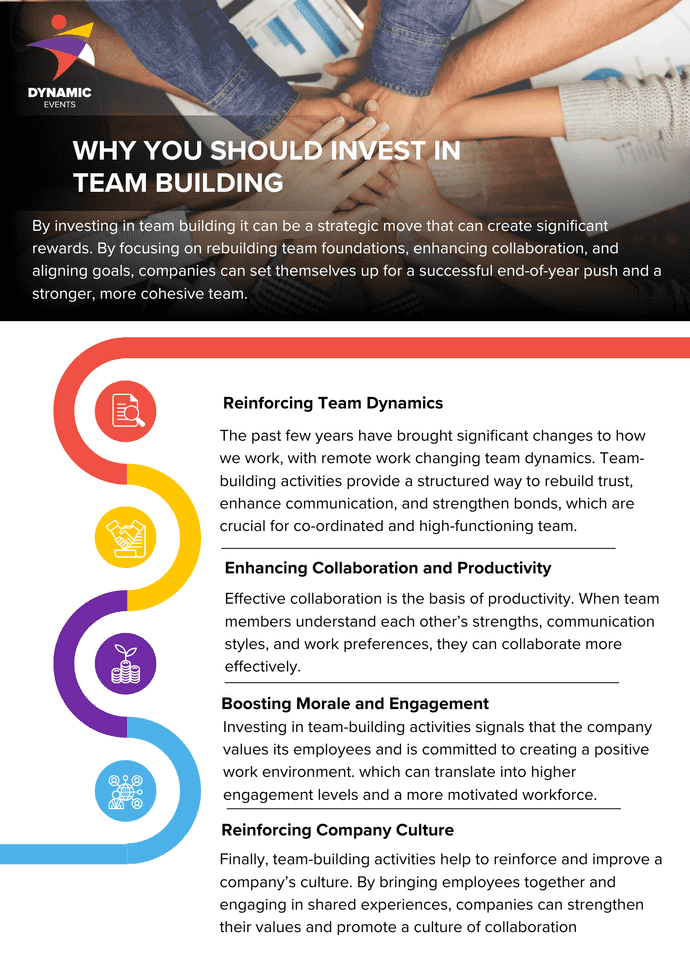Building a remote work culture of collaboration and engagement requires clear communication and leveraging technology. Fostering trust and inclusivity is also essential.
Remote work has become a norm, making it crucial to cultivate a collaborative and engaging work culture. Clear communication is the cornerstone of effective remote teams. Utilizing digital tools like Slack, Zoom, and project management software helps maintain seamless interactions.
Trust and inclusivity play vital roles in ensuring team members feel valued and heard. Regular virtual meetings, team-building activities, and transparent feedback systems keep everyone aligned and motivated. Encouraging a culture of openness and support helps bridge the gap created by physical distance. By prioritizing these elements, organizations can thrive in a remote work environment.

Credit: www.dynamicevents.ie
Embracing Remote Work
Remote work is no longer a trend; it’s a reality for many. Companies are adopting remote work to stay competitive. Embracing remote work means creating a culture of collaboration and engagement. This culture helps teams thrive even when they are miles apart.
Benefits Of Remote Work
Remote work offers many benefits to both employees and employers. Here are some key advantages:
- Increased Productivity: Employees can work in their preferred environment.
- Cost Savings: Less spending on office space and utilities.
- Flexibility: Workers can balance their personal and professional lives better.
- Wider Talent Pool: Hiring is not limited by geography.
Challenges And Solutions
Building a remote work culture has its challenges. Here are some common issues and their solutions:
| Challenge | Solution |
|---|---|
| Communication Gaps | Use reliable communication tools. Schedule regular check-ins. |
| Isolation | Encourage virtual team-building activities. Promote social interaction. |
| Time Management | Set clear expectations. Use project management software. |
| Trust Issues | Establish transparent policies. Foster a culture of trust and accountability. |
By addressing these challenges, companies can create a thriving remote work culture. This culture will ensure both collaboration and engagement among remote teams.

Credit: bonusly.com
Foundation Of Collaboration
Building a remote work culture of collaboration and engagement starts with a strong foundation. This foundation ensures every team member feels connected and motivated. Let’s dive into the key elements that make this possible.
Effective Communication Tools
Effective communication tools are vital for remote teams. They help everyone stay informed and connected.
- Instant Messaging: Tools like Slack and Microsoft Teams allow quick chats.
- Video Conferencing: Zoom and Google Meet enable face-to-face interactions.
- Project Management: Trello and Asana keep tasks organized and visible.
These tools ensure that communication is clear and timely. They also reduce misunderstandings and delays.
Collaborative Workspaces
Collaborative workspaces bring team members together, even when miles apart. These spaces foster creativity and teamwork.
- Shared Documents: Google Docs and Microsoft Office 365 allow real-time editing.
- Virtual Whiteboards: Miro and MURAL let teams brainstorm visually.
- File Sharing: Dropbox and Google Drive offer easy access to shared files.
Using these tools helps teams work together efficiently. They bridge the gap between remote locations and create a unified work environment.
Fostering Engagement
In a remote work environment, keeping employees engaged is crucial. Engaged employees are more productive and satisfied with their jobs. Here are some effective ways to foster engagement in remote teams.
Virtual Team Building Activities
Virtual team building activities help create a sense of community. These activities can be fun and interactive. Examples include:
- Online trivia games
- Virtual escape rooms
- Weekly coffee chats
- Remote book clubs
These activities encourage team bonding and improve communication. They also make work more enjoyable.
Employee Recognition Programs
Employee recognition programs are essential for remote teams. Recognizing efforts boosts morale and motivates employees. Here are some ways to implement these programs:
| Recognition Type | Description |
|---|---|
| Public Shout-outs | Acknowledge achievements in team meetings |
| Gift Cards | Reward employees with digital gift cards |
| Employee of the Month | Highlight one employee’s exceptional work |
These programs show employees their work is valued. This leads to higher employee satisfaction and retention.

Credit: www.atlassian.com
Leadership In Remote Teams
Effective leadership is crucial in any setting. But it becomes even more important in remote teams. Leaders must foster collaboration and engagement. This helps create a thriving remote work culture.
Leading By Example
Great leaders lead by example. They set the tone for the team. They show how to communicate, collaborate, and stay productive. Leaders should maintain a positive attitude. They should be responsive and accessible. This helps build a culture of accountability and trust.
Building Trust Remotely
Trust is the foundation of any successful team. In remote settings, it is even more vital. Here are some key strategies to build trust remotely:
- Regular Communication: Schedule regular check-ins with the team. Use video calls to make it personal.
- Transparency: Share company updates openly. Make sure everyone feels included.
- Recognition: Acknowledge good work publicly. Celebrate team achievements.
- Support: Offer help when needed. Show that you care about their well-being.
Building trust remotely requires consistent effort. But the rewards are worth it. A trusted team is more engaged and productive.
Maintaining Productivity
Maintaining productivity in a remote work environment requires effective strategies. Employees must stay on task and engaged despite physical distance. This section explores key methods for sustaining productivity in remote teams.
Setting Clear Goals
Clear goals give direction and purpose. Every team member should know their objectives. Use SMART goals (Specific, Measurable, Achievable, Relevant, Time-bound). This method ensures clarity and focus.
- Specific: Define clear tasks.
- Measurable: Track progress easily.
- Achievable: Set realistic expectations.
- Relevant: Align with team objectives.
- Time-bound: Establish deadlines.
Regular check-ins help maintain alignment. Use project management tools like Asana or Trello. These platforms track tasks and deadlines effectively.
Time Management Strategies
Time management is crucial for remote work. Encourage employees to use the Pomodoro Technique. This method involves working for 25 minutes, then taking a 5-minute break.
Provide tools like time-tracking software. Tools such as Toggle or Clockify help monitor work hours.
| Tool | Purpose |
|---|---|
| Toggle | Tracks daily work hours |
| Clockify | Monitors project time |
Creating a daily schedule helps structure the day. Encourage employees to list their tasks. Prioritize tasks based on importance and deadlines.
- Start with the most important task.
- Break tasks into smaller steps.
- Allocate specific time slots for each task.
Communication is key. Use tools like Slack or Microsoft Teams for quick updates and feedback.
Creating A Positive Work Environment
Building a remote work culture requires focus on collaboration and engagement. A positive work environment is key. It helps employees feel valued and motivated. Let’s explore ways to foster this environment.
Promoting Work-life Balance
Work-life balance is essential for remote teams. It keeps employees happy and productive. Here are some tips:
- Set clear working hours.
- Encourage regular breaks.
- Offer flexible schedules.
Having a good balance between work and life helps employees stay engaged.
Mental Health Support
Mental health is vital in a remote work setting. Support your team with these steps:
- Provide access to mental health resources.
- Encourage open communication.
- Offer virtual wellness programs.
Boosting mental health improves overall work satisfaction.
| Support Type | Description |
|---|---|
| Resources | Access to counseling and online tools. |
| Communication | Regular check-ins and open forums. |
| Wellness Programs | Yoga, meditation, and fitness sessions. |
By supporting mental health, you create a positive work environment.
Continuous Learning And Development
Building a remote work culture relies on continuous learning and development. This keeps team members engaged and collaborative. It ensures that everyone stays updated with the latest skills and knowledge.
Online Training Programs
Online training programs are essential for remote work. They offer flexibility and accessibility. Employees can learn at their own pace. This removes geographical barriers and time constraints.
Benefits of online training:
- Flexible scheduling
- Access to a wide range of courses
- Cost-effective
| Platform | Features |
|---|---|
| Coursera | University courses, certificates |
| Udemy | Wide variety of topics, lifetime access |
| LinkedIn Learning | Professional development, expert instructors |
Personal Growth Opportunities
Personal growth opportunities are key for employee engagement. Encourage workers to pursue their interests and passions. This leads to a more motivated and satisfied workforce.
Ways to promote personal growth:
- Offer mentorship programs
- Provide access to self-improvement resources
- Support attending conferences and workshops
Fostering a culture of continuous learning and personal growth benefits everyone. Employees feel valued and invested in. The company gains a more skilled and engaged workforce.
Measuring Success
Building a remote work culture of collaboration and engagement is crucial. But how do you measure its success? Metrics and feedback help in assessing effectiveness. Below, we explore key performance indicators and feedback methods.
Key Performance Indicators
Key Performance Indicators (KPIs) help you evaluate progress. They show if your remote work culture is successful. Here are some critical KPIs to consider:
- Employee Productivity: Measure tasks completed and goals achieved.
- Team Engagement: Track participation in meetings and collaborative tools.
- Communication Efficiency: Monitor message response times and clarity.
- Project Timeliness: Evaluate deadlines met and project milestones.
Use a table to track these KPIs easily:
| KPI | Measurement | Target |
|---|---|---|
| Employee Productivity | Tasks Completed | 90% of set goals |
| Team Engagement | Meeting Participation | 80% attendance |
| Communication Efficiency | Response Times | Within 24 hours |
| Project Timeliness | Deadlines Met | 95% on time |
Feedback And Improvement
Feedback is vital for continuous improvement. Collect feedback from employees regularly. This helps in understanding their needs and challenges. Use anonymous surveys and one-on-one meetings for honest opinions.
Here are some effective feedback methods:
- Anonymous Surveys: Ensure honest responses without fear.
- One-on-One Meetings: Personalize feedback and address specific issues.
- Team Discussions: Foster open communication within the team.
Act on the feedback received. Make necessary adjustments to improve the remote work culture. This shows employees that their opinions matter. It boosts morale and engagement.
Frequently Asked Questions
What Are The Benefits Of Remote Work Culture?
Remote work culture boosts productivity, flexibility, and employee satisfaction. It reduces commuting time and operational costs. Employees enjoy a better work-life balance.
How To Ensure Collaboration In Remote Teams?
Use collaboration tools like Slack and Zoom. Schedule regular meetings and encourage open communication. Foster a supportive team environment.
What Strategies Improve Remote Employee Engagement?
Provide regular feedback and recognition. Organize virtual team-building activities. Offer professional development opportunities and ensure clear communication of goals.
How To Build Trust In Remote Teams?
Establish transparent communication channels. Set clear expectations and deadlines. Encourage team members to share their progress and challenges.
Conclusion
Fostering a remote work culture of collaboration and engagement is essential. Prioritize communication, trust, and team-building activities. Utilize technology to bridge gaps and support your team. Empower employees to collaborate and stay engaged. This approach will lead to a more productive and satisfied remote workforce.
Your team’s success depends on a strong, collaborative culture.

